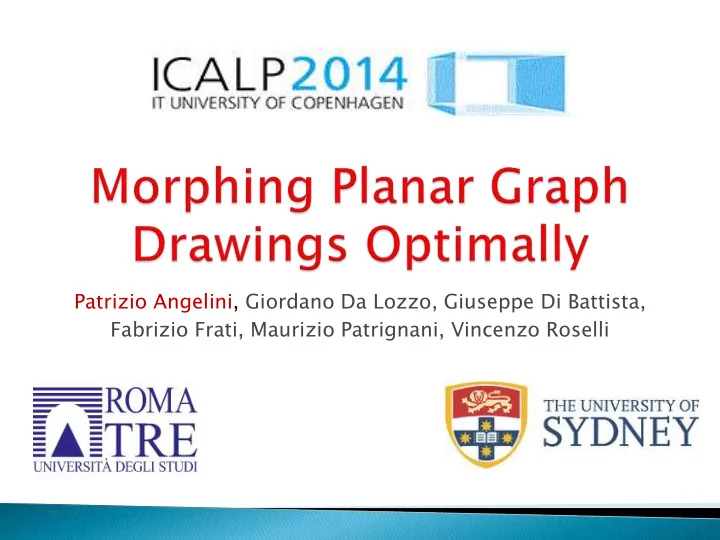

Patrizio Angelini, Giordano Da Lozzo, Giuseppe Di Battista, Fabrizio Frati, Maurizio Patrignani, Vincenzo Roselli
Graph G = (V,E) Vertices are points Edges are straight-line segments Planar: edges do not cross each other
Metamorphosis I -- M. C. Escher
Morphing is a special effect in motion pictures and animations that changes (or morphs) one image or shape into another through a seamless transition. (Wikipedia)
… changes (or morphs) one planar graph drawing into another through a seamless transition Vertices move at uniform speed along straight-line segments Planarity is preserved during the whole morph (…)
Some pairs of drawings require several steps The complexity of a morphing algorithm is defined as the number of steps it performs
Tietze, Rend. Circ. Matematico di Palermo , 38(1):247-304, 1914 We are in the centennial of the Morphing problem!
Smith, 1917 Veblen, 1917 Alexander, 1923
Cairns, 1944 A planar morph exists between any two planar drawings of any maximal planar graph (with an exponential number of steps)
Thomassen, Journal of Combinatorial Theory B, 1983 A planar convex morph exists between any two planar convex drawings of any maximal planar graph, (with an exponential number of steps)
Aicholzer et al, 2011 Lubiw Petrick, 2011 Floater, Gotsman, Surazhsky Biedl et al., 2006 several papers
Alamdari et al., SODA 2013 A planar morph exists between any two planar drawings of any maximal planar graph, (with a polynomial numer of steps) O(n 2 ) steps for maximal planar O(n 4 ) steps for maximal planar
Barrera-Cruz et al., MCDMCG, 2013 Angelini et al., GD 2013
Barrera-Cruz et al., MCDMCG, 2013 At each morphing step, all the vertices move along the same direction Angelini et al., GD 2013
Barrera-Cruz et al., MCDMCG, 2013 At each morphing step, all the vertices move along the same direction Angelini et al., GD 2013 Maximal Planar graphs in O(n 2 ) steps Series-parallel graphs in O(n) steps
Theorem 1 : There exist an algorithm to morph planar graph drawings in O(n) steps Theorem 2 : There exist two drawings of a planar graph (a path) such that morphing one into the other requires at least Ω (n) steps
Every planar graph contains at least a vertex of degree at most 5 with no chord between its neighbors By Euler’s formula, |E| <= 3n -6
Every polygon with at most 5 vertices has at least one vertex on the boundary of its kernel
Every polygon with at most 5 vertices has at least one vertex on the boundary of its kernel
Contraction of a low-degree vertex on one of its neighbors
1: Select a vertex v of v low degree. v It might be contractible on different neighbors in the two drawings
2: Contract v in both v the drawings. v We obtain different graphs! O(1) O(1)
3: Remove v and v compute a drawing in v which the polygon of its neighbors is convex O(1) O(1)
In this drawing, passing v from one neighbor to v the other is always possible! O(1) O(1)
In this drawing, passing v from one neighbor to v the other is always possible! O(1) O(1)
In this drawing, passing v from one neighbor to the v other is always possible! O(1) O(1) O(1)
Recursively morph the two v contracted drawings to the v convex ones in T(n-1) steps T(n) = 2 T(n-1) + O(1) = O(2 n ) O(1) O(1) O(1) T(n-1) T(n-1)
The morph is not to a v specific convex drawing! v O(1) O(1) O(1) O(n) T(n-1)
The morph is not to a v specific convex drawing! v T(n) = T(n-1) + O(n) = O(n 2 ) O(1) O(1) O(1) O(n) T(n-1)
The morph is to a (very) v specific convex drawing! v O(1) O(1) O(1) O(1) T(n-1)
The morph is to a (very) v specific convex drawing! v T(n) = T(n-1) + O(1) = O(n) O(1) O(1) O(1) O(1) T(n-1)
Given: ◦ a triconnected planar graph G = (V,E) ◦ A set L of parallel lines ◦ A mapping of the vertices of V to lines of L such that orienting the edges of E according to the order of the lines in L yields an st-orientation of G st-orientation: each face is composed of two oriented paths Then, G admits a convex drawing in which each vertex of V lies on the line of L it is mapped to Hong, Nagamochi. J. of Discrete Algorithms, 2010
Hong, Nagamochi. J. of Discrete Algorithms, 2010
A linear number of steps are necessary to morph one of these drawings into the other ◦ There exists an edge that must perform a linear number of complete rotations ◦ In a single step, only (a bit less than) half rotation can be performed
All the algorithms produce intermediate drawings on a very large grid ◦ What about morphing on a limited-size grid? ◦ Can we avoid contractions? Can we produce convexity-preserving morphings with a polynomial number of steps? How to morph non-planar graphs?
Recommend
More recommend